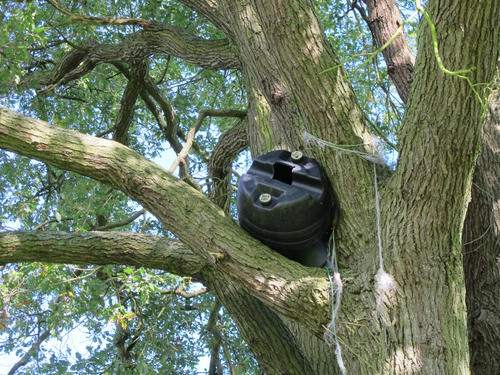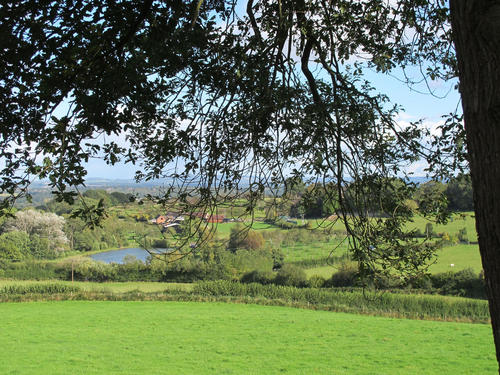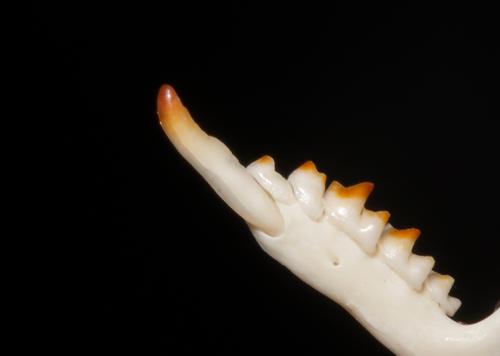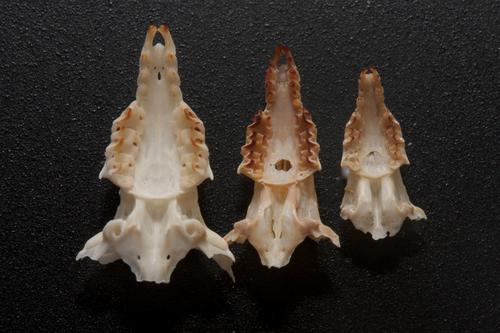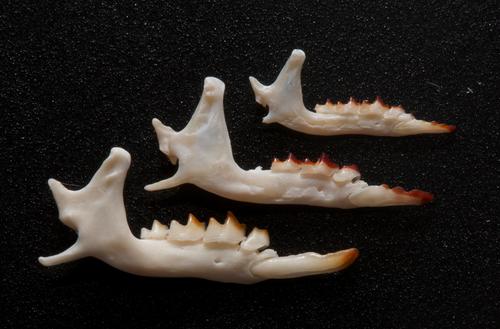Water Shrew bones in an Owl Box
Rosemary Winnall
It has long been accepted that the identification of bones from owl pellets is a good way of obtaining records of small mammals. This is something I have been doing for some time and I am always on the look out for local roosting and breeding holes used by Tawny Owls or Barn Owls, as these can provide a regular source of pellets.
Barn Owls are known to have roosted and bred regularly in artificial nest boxes at Haye Farm near Bewdley (SO778741) for about ten years from 1998, although during the last four years they have only been seen intermittently. During the spring of 2012 the farmer, Stuart Norgrov,e cleaned out one of his eight owl boxes and asked me if I wanted the contents for checking. I was enthusiastic, but when they arrived in two large fertiliser bags via Brenda Rea, I realised that I had grossly underestimated the size of the task, and there was an enormous amount of material to sort! The owl box from which this came (Owl Box 2) is a large black drum high in a veteran hedgerow oak tree about 400m from the farm buildings (see Figs. 1 and 2). I had already received a box containing the debris from one of the other owl boxes - a smaller wooden triangular owl box that had been up inside one of the barns (Owl Box 1).
We could not, of course, presume that all the material came from Barn Owl pellets. We knew that Kestrels, Tawny Owls and Little Owls had all held territories in the vicinity of the farm, and these, as well as other creatures, might have used the box at some time. But nevertheless, any small mammal records that we could obtain would make valuable records for this locality.
Firstly I recruited the help of Mick Blythe and his battery-powered pooter. (We didn’t like the thought of sucking up creatures from such material with standard pooters as you can imagine!). We opened the bags and collected anything that moved - moths, flies and beetles went into the tubes and were saved for later identification. Caterpillars were extracted and all lepidoptera given to Tony Simpson. Beetles went to John Meiklejohn and Mick took the flies for identification.
Then we donned gloves and sorted through the material bit by bit, taking out skulls and lower jaws. These were then soaked overnight in hot soapy water with disinfectant, after which identification could begin. First I sorted the skulls and lower jaws into those of voles, mice, shrews and others, and it was a long business with 836 skulls examined and many more lower jaws checked. Then I went back and identified the species in each group, and it was then that I got a surprise (see table below for the results)!
Whilst checking the shrew bones, I soon realised that I had the lower jaws and skulls of some Water Shrews (see photos 3, 4, and 5)! I had not found these in owl pellets before! Dormice yes, but not Water Shrews! This is an excellent record of a small mammal that is so rarely seen and recorded in Worcestershire. The difficulty is that we don’t know how recently the Water Shrews were caught - some time within the last 14 years! Are they still present and if so, where do they live? (See Figs. 3, 4, & 5.)
The Mammal Society conducted a Water Shrew Survey during 2004/2005 and I was interested to find out how they had gained evidence that this species was present. Shrews need to consume very regular amounts of food and soon die if they are left in traps for too long. Indeed, without a license to trap shrews Longworth traps could not be used. The Mammal Society gained most information by setting up feeding tunnels, collecting the droppings, and checking their contents. This seemed the way forward.
So I have made some feeding tubes by cutting 4cms. wide white tubing into 20cms. lengths and covering one end of each with gauze held with a rubber band. I have received permission to place these tubes, baited with dried mealworms, around the watercourses on the farm to see if I can obtain any evidence that these endearing little mammals are present. It might not work, but it is worth a try. Watch this space!
Many thanks are due to Stuart Norgrove for his enthusiasm for the wildlife around his farm, and for his interest in this project.
Species | Owl Box 1 skulls | Box 1% of species | Owl Box 2 skulls | Box 2% of species | Total skulls | Total % |
| Field Vole | 172 | 70% | 406 | 68.7% | 578 | 69% |
| Common Shrew | 31 | 12.6% | 87 | 14.7% | 118 | 14% |
| Wood/Yellow-necked Mouse | 28 | 11.4% | 43 | 7.3% | 71 | 8.5% |
| Bank Vole | 8 | 3.2% | 25 | 4.2% | 33 | 3.9% |
| Pygmy Shrew | 3 | 1.2% | 22 | 3.7% | 25 | 2.9% |
| Water Shrew | 2 | 0.8% | 4 | 0.7% | 6 | 0.7% |
| Rat | 1 | 0.4% | 4 | 0.7% | 5 | 0.6% |
| Bird | 2 | 0.8% | 1 | 0.17% | 3 | 0.35% |
| TOTAL | 245 | 591 | 836 |
Table of results from identifying skulls in material from two owl boxes from Haye Farm near Bewdley.
Images
Fig. 1. Hayes Farm owl box 2
Fig. 2. View down to Haye Farm from Owl Box 2 tree
Fig. 3. Close up of Water Shrew lower jaw to show lack of cusps on front tooth
Fig. 4. Difference in skull size left Water Shrew, middle Common Shrew, right Pygmy Shrew
Fig. 5. Lower jaw bones top Pygmy Shrew, middle Common Shrew, bottom Water Shrew
